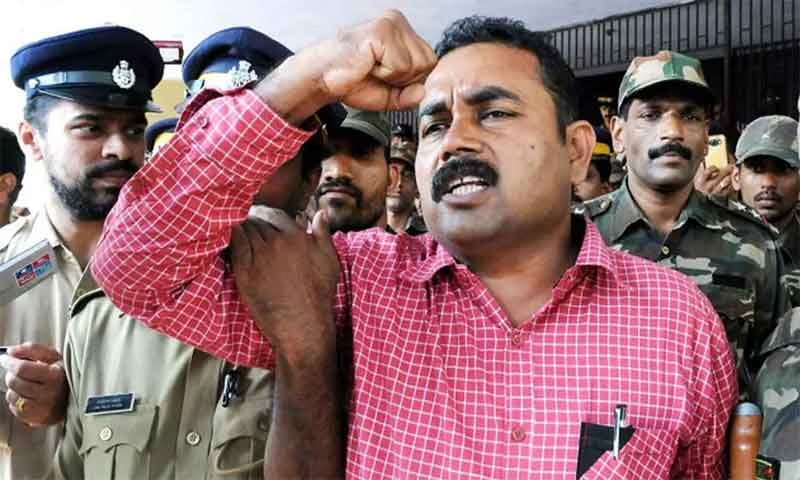
Roopesh, the Maoist leader currently incarcerated in Viyyur Central Prison, Kerala, has initiated an indefinite hunger strike in protest against the jail authorities’ refusal to grant permission for the publication of his latest novel. The manuscript of the novel is currently in circulation, and several prominent writers have read it, as indicated in social media posts in support of Roopesh. This is not his first literary endeavour while imprisoned; he previously authored a novel that was published in Kerala under two titles—Vasanthathile Poomarangal (Flowering Trees of Spring) and Maoist.
His latest work, Memoirs of the Incarcerated, is a deeply political allegory that resonates with contemporary realities, particularly evoking the experience of Stan Samy’s incarceration. The novel follows the harrowing journey of a renowned poet, imprisoned in his old age under the Unlawful Activities (Prevention) Act (UAPA), detailing the legal proceedings of his bail application—a case that reflects the political climate of our times and attests to Roopesh’s creative depth as a writer.
In a democratic society like India, prison should not be an isolated entity detached from society; rather, it is embedded within its structures, reflecting the complexities of justice, crime, and punishment. The prison system extends beyond its walls, influencing broader social and political dynamics. The right of prisoners to write and publish is not merely a question of individual expression but a crucial aspect of recognizing the human dimension of punishment and acknowledging its relative nature. Writing serves as a powerful tool for reflection, resistance, and self-rehabilitation, and to deny prisoners the opportunity to share their thoughts with the world is not a legitimate component of their sentence. The paradox of celebrating Kafka’s The Trial while silencing those who inhabit Kafkaesque realities in contemporary society exposes a fundamental hypocrisy—one that Roopesh’s novel seeks to confront.
At its core, the narrative is a documentation of the absurdity of an eminent poet’s arrest and his subsequent experiences in prison. The protagonist, a relentless critic of the system, finds himself ensnared in a judicial and penal machinery that is as dehumanizing as it is arbitrary. The narrative unfolds across multiple layers. It vividly portrays the poet’s struggle in custody, the indignities he suffers at the hands of prison authorities, and the varying attitudes of officials—some of whom recognize and admire his work, while others treat him with the same disdain as any ordinary criminal. His frailties in old age and his granddaughter’s desperate attempts to secure his release form another significant thread in the novel. Through recollections and flashbacks, the story also revisits moments when the poet was revered and loved, contrasting his present humiliation with his past intellectual and artistic acclaim.
The novel does not merely recount the protagonist’s suffering but also lays bare the systemic brutality of the prison regime. It exposes the routine dehumanization of inmates, the psychological and physical torture they endure, and the unchecked humiliation they are subjected to, including being stripped naked at the whims of prison officials. However, the novel reaches its most intense point when the imprisoned poet files a bail petition, setting off a tense legal battle. The prison authorities vehemently oppose his release, turning the proceedings into a larger political struggle, further reflecting the grim realities of justice, punishment and legal system.
The protagonist is an internationally renowned literary figure, a former office bearer of a prestigious Sahitya Academy, and a recipient of numerous awards for his contributions to literature. However, in the novel, his arrest stemmed from an entirely tenuous and politically motivated premise. The initial grounds for his detention were linked to the arrest of Murmu, a Santali poet, from Jharkhand, who was alleged to have ties to an organization suspected of being a front for Maoist activities. The name Murmu perhaps evokes the legacy of numerous writers, both past and present, across genders in Santali language, including Pandit Raghunath Murmu, Sadhu Ramchand Murmu, and many others. During the analysis of Murmu’s laptop, the police discovered that the poet had sent four letters to Murmu, and Murmu, had, confessed that the person who had most influenced his ideological development was the arrested poet himself.
Understanding that this friable association may not suffice as a justification for his arrest, law enforcement authorities pursued further means to implicate the poet. A particularly absurd and draconian turn came when investigators used Artificial Intelligence to analyse his literary corpus, attempting to demonstrate that his poetry contained subversive, anti-national content—an analysis that relied on an AI-driven application, allegedly developed indigenously for national security purposes.
According to the prosecution, this app was designed to analyse texts in a supposedly objective and dispassionate manner, detecting violations of specific legal provisions when prompted. In this case, the authorities claimed that they had used the software to examine the poet’s body of work, specifically instructing it to identify content that could be linked to violations under Sections 124A (sedition), 121A (conspiracy to wage war against the state), 153A (promoting enmity between different groups), 153B (imputations prejudicial to national integration), and 505 (statements creating public mischief) of the Indian Penal Code (IPC). Based on this analysis, they presented a distorted and utterly farcical interpretation of the poet’s celebrated works, arguing that his writings posed a direct threat to national security.
To further justify their claims, the authorities asserted that the AI system had been developed domestically, emphasizing that it was not based on foreign technology and was therefore highly reliable. The app, they claimed, operated along three levels of classification. The first category—highly probable—indicated immediate danger and required urgent arrest and trial of the individual. The second category—probable—did not necessitate arrest but justified continuous surveillance, a process they referred to as “digital patrolling,” wherein law enforcement would monitor an individual’s online and offline activities for potential threats. The third category—low risk—still warranted scrutiny but at a less intense level. The authorities argues that the poet’s work fell squarely within the highly probable category, meaning his arrest was not only justified but imperative, even if the Murmu case had not occurred. This extraordinary and dangerous precedent—a legal case built on algorithmic analysis of literature—demonstrates the increasing reliance on digital technologies to stifle dissent, criminalize intellectual discourse, and weaponize artificial intelligence as an instrument of state control.
The novel is structured around this absurdist argument, meticulously dissecting and elaborating upon the so-called findings of the state’s AI-driven analysis. What makes this aspect of the novel particularly compelling is its creative ingenuity—its ability to construct a fictional world that mirrors reality while exposing the hollow spectacle of state power. By portraying government agencies as operating with a mix of exaggerated seriousness and unwitting comedy, the novel underscores the performative nature of authoritarianism, where the rhetoric of national security often conceals an underlying void of reason and legitimacy. The state and its institutions, rather than appearing as formidable entities, are revealed to be reliant on fragile, self-contradictory logic, which the novel methodically unravels.
A significant portion of the narrative is devoted to the prosecution’s examination of the poet’s work. His poems, which passionately critique injustice and oppression, are twisted into evidence of incitement to anti-state terror and rebellion. The novel powerfully satirizes the judicial and bureaucratic mechanisms that interpret dissent as sedition, mirroring real-world attempts to criminalize free thought. The core thematic thrust of the novel is an incisive critique of how modern states, particularly those operating under the façade of democracy, respond to intellectual resistance—not through engagement or debate, but through surveillance, suppression, and outright censorship. The novel ultimately warns of a dystopian trajectory in which illiberal democracies erode civil society, constricting spaces for free speech, artistic expression, and political creativity until they collapse into full-fledged authoritarian regimes.
In its treatment of bureaucracy, persecution, and the absurdity of power, the novel resonates deeply with the works of Franz Kafka. The protagonist’s predicament is reminiscent of The Trial, where Josef K. finds himself ensnared in a nightmarish legal system that refuses to reveal its accusations while simultaneously presuming his guilt.
Just as Kafka’s world is governed by an impersonal, labyrinthine bureaucracy that metes out judgment without justification, the poet in this novel is subjected to an absurd, AI-generated indictment, where language itself becomes a tool of repression. In The Castle, Kafka explores the illusion of authority—where power appears omnipotent but is ultimately elusive, arbitrary, and often meaningless. The novel, like Kafka’s works, presents a vision of a world where individuals are trapped in endless cycles of accusation and justification, where logic is weaponized against reason, and where state power derives its strength not from justice, but from the sheer force of its mechanisms of control.
At its heart, this novel is a darkly satirical reflection on the precariousness of freedom in an era of digital surveillance and authoritarian expansion. It warns that when the state appropriates technological advancements to police thought and silence dissent, democracy itself becomes a fiction—one that is sustained only by the illusion of legality, much like Kafka’s protagonist who, despite his desperate attempts, never escapes the clutches of the law that condemns him without cause.
The issue at stake here is that the case is not merely about literary censorship; it highlights a deeper, pan-Indian concern about how writers are increasingly perceived as potential threats to the nation-state. It underscores the growing tension between authoritarian impulses and the very principles of free expression and social justice that the world’s democracies claim to uphold. The outcome of this controversy will likely serve as a litmus test for the LDF’s commitment to democratic values in the face of its long-standing ideological anxieties. As numerous writers and activists in Kerala have emphatically pointed out, the silencing of Roopesh’s novel by the prison authorities is not merely an act of censorship—it is a blatant violation of fundamental human rights. This is not just a novel—it is a document of resistance, a critique of power, and a profound inquiry into the intersection of justice, freedom, and creative expression. Its suppression only makes its voice more urgent.
Subscribe to Our Newsletter
Get the latest CounterCurrents updates delivered straight to your inbox.
T T Sreekumar, Ph.D, Professor | Department of Communication, School of Interdisciplinary Studies, Director (i/c), Educational Multimedia Research Center (EMMRC), The English and Foreign Languages University, Hyderabad
















































